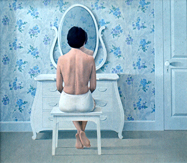

 Starting
with the painting of Woman
at a Dresser (1964), Christopher
Pratt began a period of about 20 years in which he completed many works
of the female figure. These images are done mostly in paints or in graphite,
with the exception of a few lithographs, such as Nude by Night Window
(1972). Starting
with the painting of Woman
at a Dresser (1964), Christopher
Pratt began a period of about 20 years in which he completed many works
of the female figure. These images are done mostly in paints or in graphite,
with the exception of a few lithographs, such as Nude by Night Window
(1972). Pratt's figure work is different from his other subjects in that he works not from memory, but from a model who poses for him. This is not to say, however, that the figure work does not have some basis in memory. The early figure works were primarily about the setting the figure was surrounded by, rather than the figure itself. Woman at a Dresser (1964), for example, is as much about the room and its furnishings as it is about the woman in it. Eventually the individuality of the models became more important to Pratt in the paintings. Therefore, the models became the primary focus of the work rather than the setting. Since this shift, the figure works have become less about the memory of a place where figures happen to be and more about the figures who inhabit those imaginary places. Figure painting was central to Pratt's training at the Glasgow School of Art but he had not done any since leaving there. He believed that going back to the figure would give his work an authenticity and a validity that his interest in landscape and structures alone might not provide. He says, "I wanted to do a nude. I hadn't drawn from life since I left [Glasgow] and that had diminished me." The models in the
figure works were usually from communities in St. Mary's Bay. Pratt realised
that they had the potential to bring a more natural quality to his paintings
than professional models. They also brought along their life experiences,
which affected the way they looked when they posed and, because of this,
the way the finished painting would look. He says, "It was a real
privilege to work with girls who were not professional models. They had
no preconceptions about art or artists, or life in the studio. The precedents
came from their world, not mine." |
